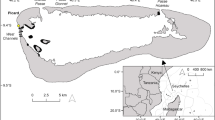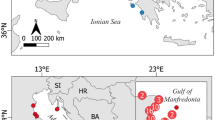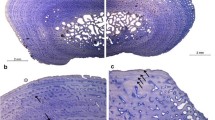Abstract
The somatic growth dynamics of green turtles (Chelonia mydas) resident in five separate foraging grounds within the Hawaiian Archipelago were assessed using a robust non-parametric regression modelling approach. The foraging grounds range from coral reef habitats at the north-western end of the archipelago, to coastal habitats around the main islands at the south-eastern end of the archipelago. Pelagic juveniles recruit to these neritic foraging grounds from ca. 35 cm SCL or 5 kg (~6 years of age), but grow at foraging-ground-specific rates, which results in quite different size- and age-specific growth rate functions. Growth rates were estimated for the five populations as change in straight carapace length (cm SCL year−1) and, for two of the populations, also as change in body mass (kg year−1). Expected growth rates varied from ca. 0–2.5 cm SCL year−1, depending on the foraging-ground population, which is indicative of slow growth and decades to sexual maturity, since expected size of first-time nesters is ≥80 cm SCL. The expected size-specific growth rate functions for four populations sampled in the south-eastern archipelago displayed a non-monotonic function, with an immature growth spurt at ca. 50–53 cm SCL (~18–23 kg) or ca. 13–19 years of age. The growth spurt for the Midway atoll population in the north-western archipelago occurs at a much larger size (ca. 65 cm SCL or 36 kg), because of slower immature growth rates that might be due to a limited food stock and cooler sea surface temperature. Expected age-at-maturity was estimated to be ca. 35–40 years for the four populations sampled at the south-eastern end of the archipelago, but it might well be >50 years for the Midway population. The Hawaiian stock comprises mainly the same mtDNA haplotype, with no differences in mtDNA stock composition between foraging-ground populations, so that the geographic variability in somatic growth rates within the archipelago is more likely due to local environmental factors rather than genetic factors. Significant temporal variability was also evident, with expected growth rates declining over the last 10–20 years, while green turtle abundance within the archipelago has increased significantly since the mid-1970s. This inverse relationship between somatic growth rates and population abundance suggests a density-dependent effect on somatic growth dynamics that has also been reported recently for a Caribbean green turtle stock. The Hawaiian green turtle stock is characterised by slow growth rates displaying significant spatial and temporal variation and an immature growth spurt. This is consistent with similar findings for a Great Barrier Reef green turtle stock that also comprises many foraging-ground populations spanning a wide geographic range.








Similar content being viewed by others
References
Aguirre AA, Spraker TR, Balazs GH, Zimmerman B (1998) Spirorchidiasis and fibro papillomatosis in green turtles of the Hawaiian Islands. J Wildl Dis 34:91–98
Balazs GH (1976) Green turtle migrations in the Hawaiian Archipelago. Biol Conserv 9:125–140
Balazs GH (1980) Synopsis of biological data on the green turtle in the Hawaiian Islands. NOAA Tech Memo NMFS-SWFSC7:1–141
Balazs GH (1982) Growth rates of immature green turtles in the Hawaiian Archipelago. In: Bjorndal KA (ed) Biology and conservation of sea turtles. Smithsonian Institution Press, Washington DC, pp 117–125
Balazs GH (1985) History of sea turtles at Polihua beach on northern Lanai. ‘Elepaio J Hawaii Audubon Soc 46:1–3
Balazs GH (1996) Behavioural changes within the recovering Hawaiian green turtle population. In: Keinath JA, Barnard DE, Musick JA, Bell BA (eds) Proceedings of the 15th annual symposium on sea turtle biology and conservation. NOAA Tech Memo NMFS-SEFSC 387:16–20
Balazs GH (1999) Factors to consider in the tagging of sea turtles. In: Eckert KL, Bjorndal KA, Abreu-Grobois FA, Donnelly M (eds) Research and management techniques for the conservation of sea turtles. Publication no. 4, IUCN/SSC Marine Turtle Specialist group, Washington DC, pp 101–109
Balazs GH (2000) Assessment of Hawaiian green turtles utilising coastal foraging pastures at Pala’au, Moloka’i. In: Bjorndal KA, Bolten AB (eds) Proceedings of a workshop on assessing abundance and trends for in-water sea turtle populations. NOAA Tech Memo NMFS-SEFSC 445:42–45
Balazs GH, Chaloupka M (2004) Thirty-year recovery trend in the once depleted Hawaiian green sea turtle stock. Biol Conserv 117:491–498
Balazs GH, Forsyth RG, Kam AKH (1987) Preliminary assessment of the habitat utilization by Hawaiian green turtles in their resident foraging pastures. NOAA Tech Memo NMFS-SWFSC 71:1–107
Balazs GH, Fujioka R, Fujioka C (1993) Marine turtle faeces on Hawaiian beaches. Mar Pollut Bull 26:392–394
Balazs GH, Dudley WC, Hallacher LE, Coney JP, Koga SK (1994) Ecology and cultural significance of sea turtles at Punalu’u, Hawai’i. In: Bjorndal KA, Bolten AB, Johnson DA, Eliazar PJ (eds) Proceedings of the 14th annual symposium on sea turtle biology and conservation. NOAA Tech Memo NMFS-SEFSC 351:10–13
Balazs GH, Puleloa W, Medeiros E, Murakawa SKK, Ellis DM (1998) Growth rates and incidence of fibropapillomatosis in Hawaiian green turtles utilising coastal foraging pastures at Pala’au, Moloka’i. In: Epperly SP, Braun J (eds) Proceedings of the 17th annual symposium on sea turtle biology and conservation. NOAA Tech Memo NMFS-SEFSC 415:131–132
Balazs GH, Murakawa SKK, Ellis DM, Aguirre AA (2000a) Manifestation of fibropapillomatosis and rates of growth of green turtles at Kane’ohe Bay in the Hawaiian Islands. In: Abreu FA, Briseno R, Marquez R, Sarti L (eds) Proceedings of the 18th international sea turtle symposium. NOAA Tech Memo NMFS-SEFSC 436:112–113
Balazs GH, Rice M, Murakawa SKK, Watson G (2000b) Growth rates and residency of immature green turtles at Kiholo, Hawai’i. In: Abreu FA, Briseno R, Marquez R, Sarti L (eds) Proceedings of the 18th international sea turtle symposium. NOAA Tech Memo NMFS-SEFSC 436:283–285
Balazs GH, Rice M, Hoffman N, Murakawa SKK, Parker DM, Shallenberger RJ (2004) Green turtle foraging and resting habitats at Midway Atoll: significant findings over 25 years from 1975–2000. In: Coyne M (ed) Proceedings of the 21st annual symposium on sea turtle biology and conservation. NOAA Tech Memo NMFS-SEFSC (in press)
Bjorndal KA (1997) Feeding ecology and nutrition in sea turtles. In: Lutz PL, Musick JA (eds) The biology of sea turtles, chap 8. CRC Marine Science Series, CRC Press, Boca Raton, Fla., pp 199–231
Bjorndal KA, Suganuma H, Bolten AB (1991) Digestive fermentation in green turtles, Chelonia mydas, feeding on algae. Bull Mar Sci 48:166–171
Bjorndal KA, Bolten AB, Chaloupka MY (2000) Green turtle somatic growth model: evidence for density-dependence. Ecol Appl 10:269–282
Bolten AB (2003) Variation in sea turtle life history patterns: neritic versus oceanic developmental stages. In: Lutz PL, Musick JA, Wyneken J (eds) The biology of sea turtles, vol 2, chap 6. CRC Marine Science Series, CRC Press, Boca Raton, Fla., pp 243–257
Bowen BW, Meylan AB, Ross JP, Limpus CJ, Balazs GH, Avise JC (1992) Global population structure and natural history of the green turtle (Chelonia mydas) in terms of matriarchal phylogeny. Evolution 46:865–881
Brill RW, Balazs GH, Holland KN, Chang KC, Sullivan S, George JC (1995) Daily movements, habitat use, and submergence intervals of normal and tumor-bearing juvenile green turtles (Chelonia mydas L.) within a foraging area in the Hawaiian islands. J Exp Mar Biol Ecol 185:203–218
Chaloupka M (2002) Stochastic simulation modelling of southern Great Barrier Reef green turtle population dynamics. Ecol Model 148:79–109
Chaloupka M (2003) Stochastic simulation modeling of loggerhead sea turtle population dynamics given exposed to competing mortality risks in the western South Pacific region. In: Bolten AB, Witherington BE (eds) The biology and conservation of loggerhead sea turtles. Smithsonian Institution Press, Washington DC, pp 274–295
Chaloupka M (2004) Exploring the metapopulation dynamics of the southern Great Barrier Reef green sea turtle genetic stock and the possible consequences of sex-biased local harvesting. In: Akçakaya H, Burgman M, Kindvall O, Wood C, Sjogren-Gulve P, Hattfield J, McCarthy M (eds) Species conservation and management: case studies. Oxford University Press, New York, pp 340–354
Chaloupka MY, Limpus CJ (1997) Robust statistical modelling of hawksbill sea turtle growth rates (southern Great Barrier Reef). Mar Ecol Prog Ser 146:1–8
Chaloupka MY, Limpus CJ (2001) Trends in the abundance of sea turtles resident in southern Great Barrier Reef waters. Biol Conserv 102:235–249
Chaloupka MY, Musick JA (1997) Age, growth and population dynamics. In: Lutz PL, Musick JA (eds) The biology of sea turtles, chap 9. CRC Marine Science Series, CRC Press, Boca Raton, Fla., pp 233–276
Chaloupka MY, Zug GR (1997) A polyphasic growth function for the endangered Kemp’s Ridley sea turtle, Lepidochelys kempii. Fish Bull (Wash DC) 95:849–856
Chaloupka MY, Limpus CJ, Miller JD (2004) Green turtle somatic growth dynamics in a spatially disjunct Great Barrier Reef metapopulation. Coral Reefs 23:(in press)
Diez CE, van Dam RP (2002) Habitat effect on hawksbill turtle growth rates on feeding grounds at Mona and Monito Islands, Puerto Rico. Mar Ecol Prog Ser 234:301–309
Dutton PH (2003) Molecular ecology of Chelonia mydas in the eastern Pacific Ocean. In: Seminoff JA (ed) Proceedings of the 22nd annual symposium on sea turtle biology and conservation. NOAA Tech Memo NMFS-SEFSC 503:69
Dutton PH, Balazs GH, Dizon AE (1997) Genetic stock identification of sea turtles caught in the Hawaii-based pelagic longline fishery. In: Epperly SP, Braun J (eds) Proceedings of the 17th annual symposium on sea turtle biology and conservation. NOAA Tech Memo NMFS-SEFSC 415:45–46
Fahrmeir L, Lang S (2001) Bayesian inference for generalised additive mixed models based on Markov random field priors. Appl Statist 50:201–220
Frazier J (1980) Exploitation of marine turtles in the Indian Ocean. Human Ecol 8:329–370
Garnett ST, Price IR, Scott FJ (1985) The diet of the green turtle, Chelonia mydas (L), in Torres Strait. Aust Wildl Res 12:103–112
Gerald CF, Wheatley PO (1994) Applied numerical analysis, 5th edn. Addison-Wesley, Reading, Mass., USA
Green D (1993) Growth rates of wild immature green turtles in the Galapagos Islands, Ecuador. J Herpetol 27:338–341
Hastie TJ (1993) Generalized additive models. In: Chambers JM, Hastie TJ (eds) Statistical models in S, chap 7. Chapman and Hall, New York, pp 249–307
Hastie TJ, Tibshirani RJ (1990) Generalized additive models. Monographs on statistics and applied probability 43, Chapman and Hall, London
Ihaka R, Gentleman R (1996) R: a language for data analysis and graphics. J Comput Graphic Statist 5:299–314
Juvik SP, Juvik JO (1998) Atlas of Hawai’i. University of Hawai’i Press, Honolulu
Leroux RA, Balazs GH, Dutton PH (2003) Genetic stock composition of foraging green turtles off the southern coast of Moloka’i, Hawai’i. In: Semonoff JA (ed) Proceedings of the 22nd annual symposium on sea turtle biology and conservation. NOAA Tech Memo NMFS-SEFSC 503:251–252
Limpus CJ, Chaloupka MY (1997) Nonparametric regression modelling of green sea turtle growth rates (southern Great Barrier Reef). Mar Ecol Prog Ser 149:23–34
Loader C (1999) Local regression and likelihood. Springer, New York Heidelberg Berlin
McCullagh P, Nelder JA (1989) Generalized linear models, 2nd edn. Monographs on statistics and applied probability 37. Chapman and Hall, London
Parsons JJ (1962) The green turtle and man. University of Florida Press, Gainsville
Rice M, Balazs GH, Kopra D, Whittow GC (2002) Ecology and behaviour of green turtles basking at Kiholo Bay, Hawai’i. In: Mosier A, Foley A, Brost B (eds) Proceedings of the 20th annual symposium on sea turtle biology and conservation. NOAA Tech Memo NMFS-SEFSC 477:153–155
Russell DJ, Balazs GH (1994) Colonization by alien marine alga Hypnea musciformis (Wulfen) J. Ag. (Rhodophyta: Gigartinales) in the Hawaiian Islands and its ultilization by the green turtle, Chelonia mydas L. Aquat Bot 47:53–60
Seminoff JA (2002) Global green turtle (Chelonia mydas) assessment for the IUCN Red List Programme. Report submitted by the Marine Turtle Specialist Group to the Species Survival Commission, Gland, Switzerland
Seminoff JA, Resendiz A, Nichols WJ, Jones TT (2002) Growth rates of wild green turtles (Chelonia mydas) at a temperate foraging area in the Gulf of California, Mexico. Copeia 2002:610–617
Whittow GC, Balazs GH (1985) Basking behaviour of the Hawaiian green turtle (Chelonia mydas). Pac Sci 36:129–139
Witzell WN (1994) The origin, evolution and demise of the US sea turtle fisheries. Mar Fish Rev 56:8–23
Work TM, Balazs GH, Wolcott M, Morris R (2003) Bacteraemia in free-ranging Hawaiian green turtles Chelonia mydas with fibropapillomatosis. Dis Aquat Org 53:41–46
Yee TW, Wild CJ (1996) Vector generalized additive models. J R Statist Soc B 58:481–493
Zug GR, Balazs GH, Wetherall JA, Parker DM, Murakawa SKK (2002) Age and growth in Hawaiian green sea turtles (Chelonia mydas): an analysis based on skeletochronology. Fish Bull (Wash DC) 100:117–127
Acknowledgements
We are especially grateful for the support provided by S. Murakawa, S. Eames, D. Parker, B. Puleloa, E. Medeiros, D. Medeiros and M. Rice (Hawai’i Preparatory Academy) and L. Hallacher, J. Coney and W. Dudley (Marine Option Program, University of Hawai’i at Hilo). We thank G. Antonelis, K. Bjorndal, A. Bolten, P. Dalzell, P. Dutton, J. Kendig, C. Limpus, J. Polovina, J. Seminoff, J. Wetherall, T. Work and G. Zug for helpful comments on the manuscript. This work was supported by a National Marine Fisheries Service contract (no. AB133F02SE0905) to the second author. This work complies with all animal experimentation and ethics standards of the USA.
Author information
Authors and Affiliations
Corresponding author
Additional information
Communicated by P.W. Sammarco, Chauvin
Rights and permissions
About this article
Cite this article
Balazs, G.H., Chaloupka, M. Spatial and temporal variability in somatic growth of green sea turtles (Chelonia mydas) resident in the Hawaiian Archipelago. Marine Biology 145, 1043–1059 (2004). https://doi.org/10.1007/s00227-004-1387-6
Received:
Accepted:
Published:
Issue Date:
DOI: https://doi.org/10.1007/s00227-004-1387-6




